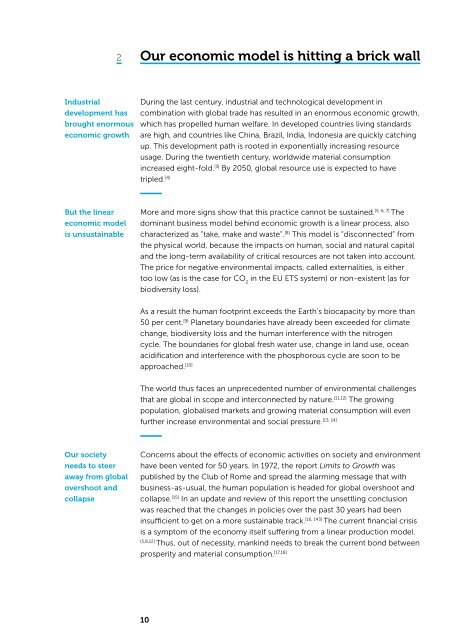Unleashing the Power of the Circular Economy
Unleashing the Power of the Circular Economy
Unleashing the Power of the Circular Economy
Create successful ePaper yourself
Turn your PDF publications into a flip-book with our unique Google optimized e-Paper software.
2<br />
Industrial<br />
development has<br />
brought enormous<br />
economic growth<br />
But <strong>the</strong> linear<br />
economic model<br />
is unsustainable<br />
Our society<br />
needs to steer<br />
away from global<br />
overshoot and<br />
collapse<br />
Our economic model is hitting a brick wall<br />
During <strong>the</strong> last century, industrial and technological development in<br />
combination with global trade has resulted in an enormous economic growth,<br />
which has propelled human welfare. In developed countries living standards<br />
are high, and countries like China, Brazil, India, Indonesia are quickly catching<br />
up. This development path is rooted in exponentially increasing resource<br />
usage. During <strong>the</strong> twentieth century, worldwide material consumption<br />
increased eight-fold. [3] By 2050, global resource use is expected to have<br />
tripled. [4]<br />
More and more signs show that this practice cannot be sustained. [5, 6, 7] The<br />
dominant business model behind economic growth is a linear process, also<br />
characterized as “take, make and waste”. [8] This model is “disconnected” from<br />
<strong>the</strong> physical world, because <strong>the</strong> impacts on human, social and natural capital<br />
and <strong>the</strong> long-term availability <strong>of</strong> critical resources are not taken into account.<br />
The price for negative environmental impacts, called externalities, is ei<strong>the</strong>r<br />
too low (as is <strong>the</strong> case for CO 2 in <strong>the</strong> EU ETS system) or non-existent (as for<br />
biodiversity loss).<br />
As a result <strong>the</strong> human footprint exceeds <strong>the</strong> Earth’s biocapacity by more than<br />
50 per cent. [9] Planetary boundaries have already been exceeded for climate<br />
change, biodiversity loss and <strong>the</strong> human interference with <strong>the</strong> nitrogen<br />
cycle. The boundaries for global fresh water use, change in land use, ocean<br />
acidification and interference with <strong>the</strong> phosphorous cycle are soon to be<br />
approached. [10]<br />
The world thus faces an unprecedented number <strong>of</strong> environmental challenges<br />
that are global in scope and interconnected by nature. [11,12] The growing<br />
population, globalised markets and growing material consumption will even<br />
[13, 14]<br />
fur<strong>the</strong>r increase environmental and social pressure.<br />
Concerns about <strong>the</strong> effects <strong>of</strong> economic activities on society and environment<br />
have been vented for 50 years. In 1972, <strong>the</strong> report Limits to Growth was<br />
published by <strong>the</strong> Club <strong>of</strong> Rome and spread <strong>the</strong> alarming message that with<br />
business-as-usual, <strong>the</strong> human population is headed for global overshoot and<br />
collapse. [15] In an update and review <strong>of</strong> this report <strong>the</strong> unsettling conclusion<br />
was reached that <strong>the</strong> changes in policies over <strong>the</strong> past 30 years had been<br />
insufficient to get on a more sustainable track. [16, 143] The current financial crisis<br />
is a symptom <strong>of</strong> <strong>the</strong> economy itself suffering from a linear production model.<br />
[5,8,12] Thus, out <strong>of</strong> necessity, mankind needs to break <strong>the</strong> current bond between<br />
prosperity and material consumption. [17,18]<br />
10



